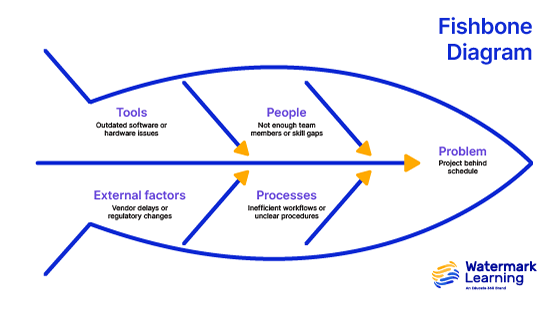- Identify root causes with techniques like the “5 Whys” to solve problems effectively, not just symptoms.
- Use tools like fishbone diagrams to structure problems and create clear action plans.
- Collaborate with stakeholders to ensure solutions are viable, aligned, and widely supported.
- Measure the impact of solutions with KPIs and feedback loops to drive continuous improvement.
The Problem with Problems: Why Your Team Needs a BA
Have you ever been in a meeting where everyone debated about the actual problem? It’s like a bad sitcom—lots of talking, zero solutions. That’s life without Business Analysis (BA): unclear objectives, misaligned teams, and too many coffee-fueled brainstorming sessions going nowhere.
Business Analysts (BAs) are the superheroes you didn’t know you needed. They dive into the chaos, uncover the real issues, and guide teams toward fixes that work. Their secret sauce? Asking the right questions, using the right tools, and ensuring everyone’s rowing in the same direction. Let’s break down how BAs do what they do best: solve problems like pros.
Problem Identification— The Art of Asking “Why?” Until It Hurts
The first step to solving a problem? Knowing what the problem is. It sounds simple, but you’d be surprised to learn how many organizations end up tackling symptoms instead of root causes. Deadlines keep getting missed, so the team decides to work overtime. But why are the deadlines being missed in the first place? That’s where root cause analysis comes in.
Enter the “5 Whys” technique. It’s like peeling an onion—you keep asking “Why?” until you get to the core issue. For example:
- Why are deadlines being missed? Because tasks are delayed.
- Why are tasks delayed? Because requirements are unclear.
- Why are requirements unclear? Because stakeholders didn’t communicate their needs effectively.
- Why didn’t stakeholders communicate effectively? Because there’s no formal process for gathering requirements.
- Why isn’t there a process? Because no one has been assigned to create one.
The real problem isn’t missed deadlines; it’s the lack of a requirements-gathering process.
Real-world example: A retail company’s sales were slipping, and they thought the issue was ineffeictive marketing. A BA stepped in and used root cause analysis to uncover the truth: their inventory system wasn’t keeping up with customer demand, leading to stockouts of popular items. Fixing the inventory system fixed the sales problem, and no extra ad spend was required.
The Power of Visualization in Problem-Solving
Once you’ve nailed down the root cause, it’s time to structure the problem. Why? Because a jumbled mess of issues is overwhelming, but a structured approach? That’s a game-changer.
Visualization tools are your best friends. BAs use things like fishbone diagrams (aka Ishikawa diagrams), SWOT analysis, and flowcharts to organize complex problems. These tools make it easier to see what’s really going on and where to focus your efforts.
Take a fishbone diagram, for instance. Say your project is behind schedule. A BA might break it down like this:
- People: Not enough team members or skill gaps.
- Processes: Inefficient workflows or unclear procedures.
- Tools: Outdated software or hardware issues.
- External factors: Vendor delays or regulatory changes.
The team can zero in on what’s causing the delays by laying everything out.

Practical example: A manufacturing company kept seeing defects in its products. A BA’s fishbone diagram showed the culprit: inconsistent supplier materials, not the production process. Armed with that insight, the company renegotiated supplier contracts, and the defects disappeared.
Why it works: Structured problem-solving takes the guesswork out of the equation and gives you a clear path forward.
Building Consensus Without the Chaos
If BAs had a motto, it would probably be, “Collaboration is key.” Why? Because even the best solution won’t work if stakeholders aren’t on board.
- BAs as connectors: Think of BAs as the glue that holds teams together. They ensure that business leaders, technical teams, and everyone in between are on the same page. Techniques like stakeholder mapping help BAs identify who needs to be involved and their priorities.
- Building consensus: Let’s face it, getting stakeholders to agree can feel like trying to referee a game of dodgeball. BAs are experts at navigating conflicts and finding common ground. They focus on facts and data to steer discussions toward actionable solutions.
- Scenario time: A customer service team was drowning in complaints. Frontline staff blamed outdated systems, while management insisted it was a training issue. A BA gathered input from both sides and found the real problem: inconsistent escalation protocols. The solution? Standardize those protocols. Complaints dropped, and everyone was happy.
The Numbers Don’t Lie: Metrics That Matter
You can’t improve what you don’t measure. That’s why BAs don’t just solve problems; they ensure the solutions work.
- Defining success: Before rolling out a solution, BAs set clear metrics for success. Whether it’s cutting costs, boosting efficiency, or improving customer satisfaction, these metrics provide a baseline for measuring impact.
- Tracking progress: Tools like dashboards, KPIs, and post-implementation reviews help BAs monitor a solution’s performance. But they don’t stop there. BAs also look for ways to tweak and refine solutions for even better results.
- Iterative improvement: Feedback loops are a BA’s best friend. By gathering data and analyzing results, they can fine-tune processes and keep things running smoothly.
- Real-world impact: A financial institution automated loan application reviews based on a BA’s recommendation. Processing times dropped by 30%, but customer feedback revealed some automated decisions lacked nuance. The BA iterated on the system, adding an escalation process for complex cases. The result? Faster reviews and happier customers.
Your Competitive Edge? A Great Business Analyst
Business Analysts are the unsung heroes of problem-solving. They uncover the real issues, structure challenges, foster collaboration, and ensure solutions deliver measurable results. Without them, organizations risk spinning their wheels and never getting anywhere.
Investing in skilled BAs or training your team in BA methodologies is one of any organization’s smartest moves. BAs don’t just solve problems—they prevent them, creating a culture of proactive, analytical thinking.
So, if your team is stuck in a cycle of endless meetings and missed deadlines, here’s the good news: a great BA can turn all that chaos into clarity. And who doesn’t want more of that?

 New Horizons
New Horizons
 Project Management Academy
Project Management Academy
 Six Sigma Online
Six Sigma Online
 Velopi
Velopi
 Watermark Learning
Watermark Learning
 Login
Login




 New Horizons
New Horizons
 Project Management Academy
Project Management Academy
 Velopi
Velopi
 Six Sigma Online
Six Sigma Online
 Watermark Learning
Watermark Learning